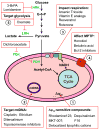Small mitochondria-targeting molecules as anti-cancer agents
- PMID: 19995573
- PMCID: PMC2836415
- DOI: 10.1016/j.mam.2009.12.003
Small mitochondria-targeting molecules as anti-cancer agents
Abstract
Alterations in mitochondrial structure and functions have long been observed in cancer cells. Targeting mitochondria as a cancer therapeutic strategy has gained momentum in the recent years. The signaling pathways that govern mitochondrial function, apoptosis and molecules that affect mitochondrial integrity and cell viability have been important topics of the recent review in the literature. In this article, we first briefly summarize the rationale and biological basis for developing mitochondrial-targeted compounds as potential anti-cancer agents, and then provide key examples of small molecules that either directly impact mitochondria or functionally affect the metabolic alterations in cancer cells with mitochondrial dysfunction. The main focus is on the small molecular weight compounds with potential applications in cancer treatment. We also summarize information on the drug developmental stages of the key mitochondria-targeted compounds and their clinical trial status. The advantages and potential shortcomings of targeting the mitochondria for cancer treatment are also discussed.
2009 Elsevier Ltd. All rights reserved.
Figures

Similar articles
-
Stress-related mitochondrial components and mitochondrial genome as targets of anticancer therapy.Chem Biol Drug Des. 2013 Jan;81(1):102-12. doi: 10.1111/cbdd.12057. Chem Biol Drug Des. 2013. PMID: 23253132 Review.
-
Delivery of drugs and macromolecules to the mitochondria for cancer therapy.J Control Release. 2016 Oct 28;240:38-51. doi: 10.1016/j.jconrel.2015.10.023. Epub 2015 Oct 19. J Control Release. 2016. PMID: 26482081 Review.
-
Targeting mitochondria in fighting cancer.Curr Pharm Des. 2011 Dec 1;17(36):4034-46. doi: 10.2174/138161211798764933. Curr Pharm Des. 2011. PMID: 22188453 Review.
-
Friend or foe? Mitochondria as a pharmacological target in cancer treatment.Future Med Chem. 2017 Dec;9(18):2197-2210. doi: 10.4155/fmc-2017-0110. Epub 2017 Nov 28. Future Med Chem. 2017. PMID: 29182013 Review.
-
Mitochondria-targeted drug delivery in cancers.Biochim Biophys Acta Mol Basis Dis. 2020 Aug 1;1866(8):165808. doi: 10.1016/j.bbadis.2020.165808. Epub 2020 Apr 22. Biochim Biophys Acta Mol Basis Dis. 2020. PMID: 32333953 Review.
Cited by
-
The Role of Mitochondria in Inflammation: From Cancer to Neurodegenerative Disorders.J Clin Med. 2020 Mar 9;9(3):740. doi: 10.3390/jcm9030740. J Clin Med. 2020. PMID: 32182899 Free PMC article. Review.
-
Nanomaterials in Medicine: Understanding Cellular Uptake, Localization, and Retention for Enhanced Disease Diagnosis and Therapy.Aging Dis. 2024 Feb 22;16(1):168-208. doi: 10.14336/AD.2024.0206-1. Online ahead of print. Aging Dis. 2024. PMID: 38421835 Free PMC article. Review.
-
TMT-Based Quantitative Proteomics Analysis Reveals the Panoramic Pharmacological Molecular Mechanism of β-Elemonic Acid Inhibition of Colorectal Cancer.Front Pharmacol. 2022 Feb 15;13:830328. doi: 10.3389/fphar.2022.830328. eCollection 2022. Front Pharmacol. 2022. PMID: 35242040 Free PMC article.
-
Sindbis Virus Replication Reduces Dependence on Mitochondrial Metabolism During Infection.Front Cell Infect Microbiol. 2022 Jun 16;12:859814. doi: 10.3389/fcimb.2022.859814. eCollection 2022. Front Cell Infect Microbiol. 2022. PMID: 35782146 Free PMC article.
-
Conjugation of Natural Triterpenic Acids with Delocalized Lipophilic Cations: Selective Targeting Cancer Cell Mitochondria.J Pers Med. 2021 May 25;11(6):470. doi: 10.3390/jpm11060470. J Pers Med. 2021. PMID: 34070567 Free PMC article. Review.
References
-
- Akiyoshi T, Matzno S, Sakai M, Okamura N, Matsuyama K. The potential of vitamin K(3) as an anticancer agent against breast cancer that acts via the mitochondria-related apoptotic pathway. Cancer Chemother Pharmacol 2009 - PubMed
-
- Arcadi JA. Rhodamine-123 as effective agent in rat prostate tumor R3327-H. Preliminary report. Urology. 1986;28:501–503. - PubMed
-
- Armstrong JS, Hornung B, Lecane P, Jones DP, Knox SJ. Rotenone-induced G2/M cell cycle arrest and apoptosis in a human B lymphoma cell line PW. Biochem Biophys Res Commun. 2001;289:973–978. - PubMed
-
- Babbs M, Collier HO, Austin WC, Potter MD, Taylor EP. Salts of decamethylene-bis-4-aminoquinaldinium (dequadin); a new antimicrobial agent. J Pharm Pharmacol. 1956;8:110–119. - PubMed
Publication types
MeSH terms
Substances
Grants and funding
LinkOut - more resources
Full Text Sources
Other Literature Sources

